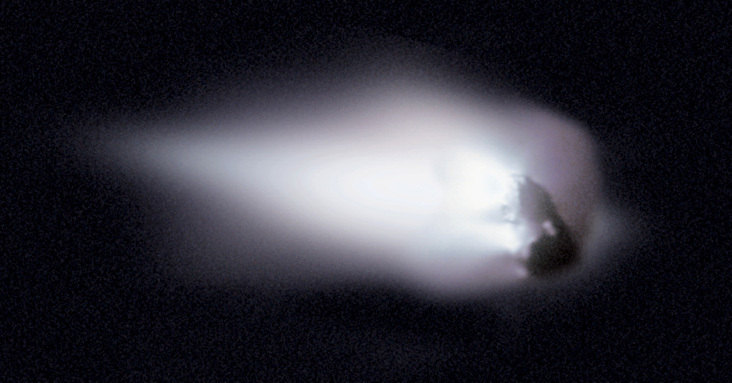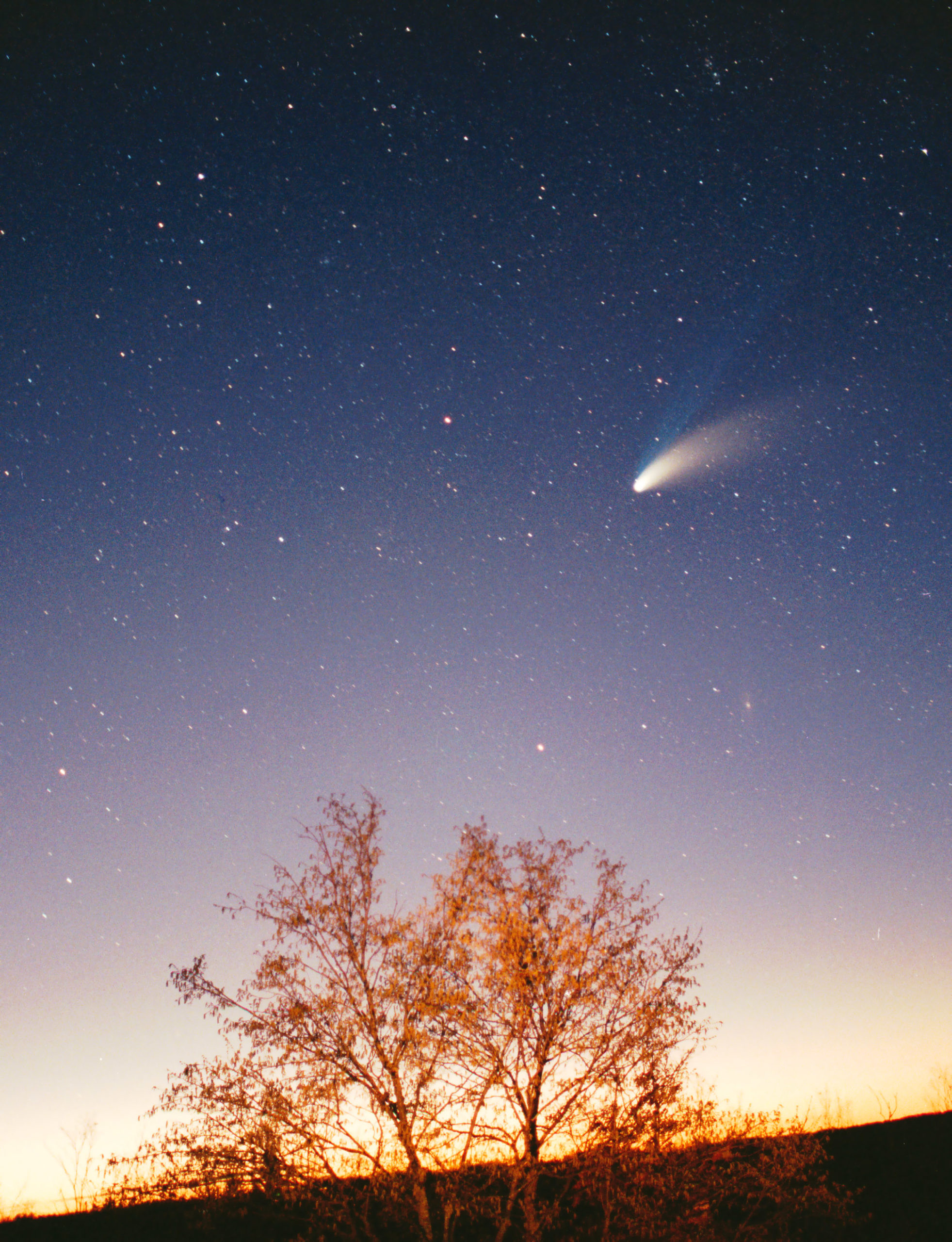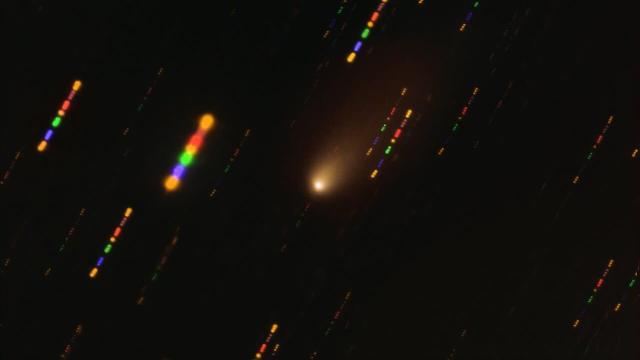New research suggests Borisov — the second known interstellar visitor to our solar system — had never previously visited a star, not even the one from its home system, prior to zipping past our Sun in 2019. That makes Borisov one of the most pristine — if not the most pristine — comet ever observed by astronomers, in what is a significant scientific discovery.
For every prospective comet out there, there’s gotta be a first time.
In the case of interstellar comet Borisov, its first time around a star just happened to be its flyby of our Sun in 2019, according to new research published today in Nature Communications.
That’s significant, not just because it’s the first time we’ve ever had a chance to observe a first-time comet (whether interstellar or local), but also because its maiden flare-up allowed astronomers to study a non-native comet and its associated chemistry. It was a rare case of an alien world, or at least a small chunk of it, coming to pay us a visit.
Indeed, and as a second Borisov-related paper published today points out, a surprising amount of information about a comet’s home system can be gleaned from the bits of dust that pour off its primeval surface.
‘Dirty snowballs’ with ancient histories
That comets have many stories to tell isn’t surprising, as these “dirty snowballs,” in the words of the American astronomer Fred Whipple, are born in the outer reaches of a planetary system. Located in Kuiper belts, these objects are ancient, but also untouched by solar wind and radiation, allowing them to store the original signatures of the gas and dust from which they formed.

Every once in a while, these dirty snowballs of frozen gases, rocks, and dust get jostled from their positions in the Kuiper belt, sending them on journeys into the inner solar system. We see these events as comets, as their surfaces, exposed to the Sun’s warmth, become active. It’s likely that many comets don’t survive their inaugural journeys into the inner solar system, but those that do sometimes come back for return visits (Halley’s comet, due back in 2061, is probably the most famous example).
In the case of Borisov, however, it also got jostled as it floated in its equivalent of our Kuiper belt, but instead of drifting toward its host star, it received a mighty gravitational shove that turned it into an interstellar traveller.
The second known traveller from afar
Discovered by amateur astronomer Gennady Borisov, 2I/Borisov is the second interstellar object ever detected, the first being ‘Oumuamua in 2017. But whereas ‘Oumuamua exhibited characteristics consistent with an asteroid (aside from some minor surface emissions), Borisov was most certainly a comet, featuring a prominent coma around its nucleus and a defined tail. It even lost a chunk during its flyby, a likely result of ice quickly turning to gas.
Travelling along its hyperbolic orbit, Borisov never got any closer to the Sun than the halfway point between Mars and Jupiter, and then it resumed its journey toward interstellar space.
That didn’t afford astronomers very much time to study the object, but the two new papers are providing some insights into the exotic object.
Untouched by any sun
The first study, led by astronomer Stefano Bagnulo from the Armagh Observatory and Planetarium in Northern Ireland, measured the polarization of light being dispersed by Borisov’s coma dust grains. Light gets polarised when it travels through different mediums, so by studying the way sunlight gets polarised by a comet’s dust, scientists can make inferences about the physics and chemistry of such objects.
In an email, Bagnulo said his team routinely applies polarimetry to “study the surface structure and composition of asteroids and other small bodies of the solar system,” and because Borisov represented the first known interstellar comet to visit our solar system, it seemed “natural to check if it exhibited different polarimetric properties than other solar system comets.” What’s more, the comet might also reveal important features of other star systems, he added.
To collect this data, Bagnulo and his colleagues used the Very Large Telescope in Chile, which is equipped with the FORS2 instrument for doing polarimetry. Managed by the European Southern Observatory, VLT has previously been used to study local comets, allowing the team to perform an apples-to-apples comparison.

Results revealed polarimetric properties not seen before in local comets, with the exception being C/1995 (Hale-Bopp). First spotted in 1995, comet Hale-Bopp was visible to the unaided eye for an unprecedented 18 months. Until now, it was the most pristine comet on record, with astronomers believing Hale-Bopp was making its second pass around the Sun at the time.
“Because polarimetry is sensitive to dust size and composition, we have suggested that the two comets shared some physical similarities, in particular regarding the pristine nature of the material that was being ejected when they approached the Sun,” explained Bagnulo. “We think that comet Hale-Bopp came close to the Sun only once before its apparition in 1997, and because of that, its material has not been processed a lot by solar wind and radiation.”
The materials observed in Hale-Bopp are “representative of the early solar system,” he said, leading his team to suggest that the environment in which Borisov formed is not very different from our own early solar system. These observations also mean that Borisov likely never encountered our Sun before — or any other star for that matter — and as a consequence, may represent the most pristine comet ever detected.
“The main result — that 2I/Borisov is not like any other comet except Hale-Bopp — is very strong,” Olivier Hainaut, an astronomer at ESO in Germany who wasn’t involved in the new study, explained in a press release. “It is very plausible they formed in very similar conditions.”
Excitingly, the European Space Agency is developing a “Comet Interceptor” — a spacecraft that will launch prior to a target being identified. The probe will “wait in space for the discovery of the imminent arrival of one of these pristine objects — and maybe even another interstellar comet — and then intercept it,” said Bagnulo.
An alien — but familiar — home world
The second paper, published in Nature Astronomy, describes the presence of large dust particles around Borisov during its active period. Bin Yang, the lead author and an astronomer at the ESO in Santiago, Chile, studied these large grains with the VLT as well as the Atacama Large Millimetre/submillimeter Array, also in Chile.
“The superb millimetre-wave sensitivity of ALMA offers the only way to directly detect the large particles in the coma of Borisov,” she explained in an email.
These observations revealed the presence of compact pebbles, all larger than 1 millimetre wide and exhibiting different characteristics from those seen in the loose materials of local comets. Also, the amounts of carbon monoxide and water in the comet changed dramatically during its flyby, suggesting it formed within a collapsing pebble cloud and from materials that originated in different parts of its home system.
[referenced id=”1681268″ url=”https://gizmodo.com.au/2021/03/interstellar-visitor-oumuamua-could-be-the-shattered-remnant-of-a-pluto-like-object/” thumb=”https://gizmodo.com.au/wp-content/uploads/2021/03/20/vomdudugfq6ifkeinsww-300×168.jpg” title=”Interstellar Visitor ‘Oumuamua Could Be the Shattered Remnant of a Pluto-like Object” excerpt=”Four years ago, astronomers detected ‘Oumuamua — the first interstellar object known to pass through our solar system. The object featured an array of strange and inexplicable characteristics, some of which are consistent with an icy shard ripped from a Pluto-like object, according to new research.”]
“This finding suggests that the home system of Borisov exchanged materials between the inner regions and the outer regions that are far from the central star, perhaps due to gravitational stirring by giant planets, much like in our own solar system,” said Yang.
So even though we have no clue as to where this thing came from, we can assume its home system is somewhat similar to ours and contains giant planets like Jupiter and Saturn.
Yang expects that astronomers will find more interstellar objects in the future, and “some of them may be remarkably different from solar system objects.” In the future, and as the next generation of telescopes comes online, we should expect to find one interstellar object per year, she predicts.
“A set of new large telescopes,” such as the James Webb Space Telescope, the Extremely Large Telescope, and the Thirty Metre Telescope, “will be available in a few years time,” said Yang. “By then, we will be able to study future interstellar visitors in greater detail.”
Amazing. And all we have to do is point our telescopes at the sky and wait.
